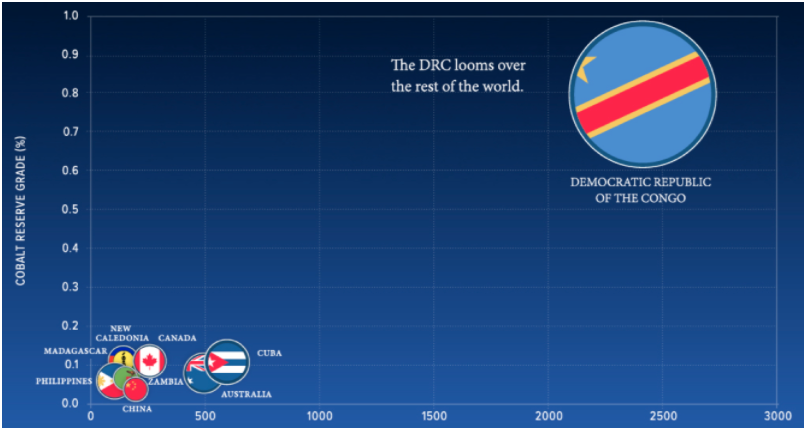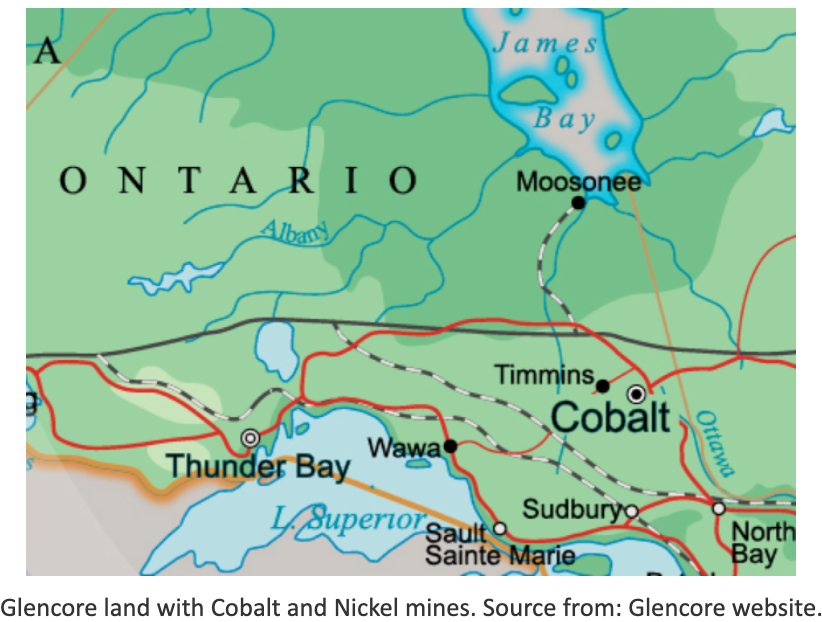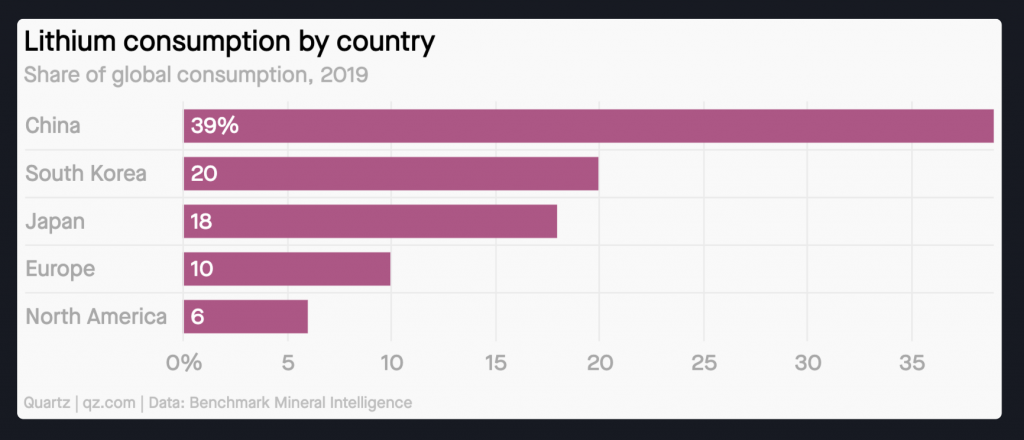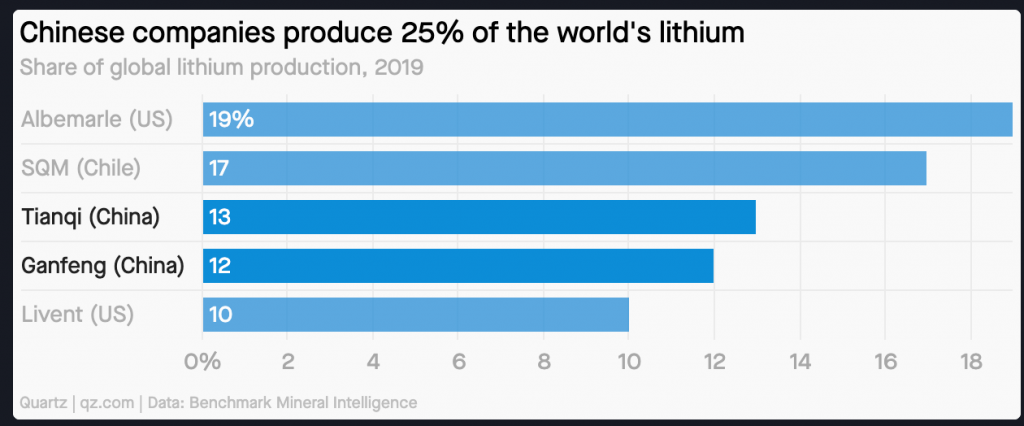Cobalt :
As we know from the market overview, DRC accounts for roughly 70% of world mined cobalt and Chinese companies account for 8 out of 14 cobalt main refineries. A market completely dominated and controlled by the two.

Image source from: https://www.visualcapitalist.com/ethical-supply-the-search-for-cobalt-beyond-the-congo/
By the time cobalt arrives for the battery manufacturing, the sources of cobalt are unknown. We do not know where it comes from anymore but since DRC is accounting for more than half of world production, it is normal to think that there is a very high chance that it comes from there. DRC has been under the radar for being a country where children are known to be working in Cobalt mines. Moreover, the working conditions have been reported to be very poor and unfortunately led to the death of thousands of people.

A lawsuit against the big Tech companies such as Apple, Microsoft, Tesla and Google has been launched in the end of 2019[1]. Congolese families are asking for damages: as mentioned above, the big techs are being accused to aid force labour, children labour and poor working conditions. Companies are now seeking a more transparent supply chain but also other sources in other to be sure that the Cobalt they are buying is considered “clean”: BMW signed a $110mio deal with Morocco’s cobalt company Bou Azzar Mine, Tesla has agreed to buy 6’000 tonnes/year of Cobalt from Glencore (we will see why further down); Companies such as Ford, IBM and LG are using block chain technology to trace accurately the source of their cobalt[2]; More interestingly, north America, Canada, explorations have started in order to find new sources of Cobalt[3]

A lawsuit against the big Tech companies such as Apple, Microsoft, Tesla and Google has been launched in the end of 2019[1]. Congolese families are asking for damages: as mentioned above, the big techs are being accused to aid force labour, children labour and poor working conditions. Companies are now seeking a more transparent supply chain but also other sources in other to be sure that the Cobalt they are buying is considered “clean”: BMW signed a $110mio deal with Morocco’s cobalt company Bou Azzar Mine, Tesla has agreed to buy 6’000 tonnes/year of Cobalt from Glencore (we will see why further down); Companies such as Ford, IBM and LG are using block chain technology to trace accurately the source of their cobalt[2]; More interestingly, north America, Canada, explorations have started in order to find new sources of Cobalt[3]

The industry is recognizing the fact that there are other sources that can be compared to what is found in the DRC. Canada is a good candidate with a possible large amount of Cobalt to be mined in Ontario. A good sign that is proving this fact is that Glencore, the biggest mining company in the world, owns many land in the area and has built the very first cobalt refinery in north America. This means that refined cobalt will be traceable from there and considered as “clean”.

https://www.google.com/maps/place/Ontario,+Canada/@48.9552626,-93.7065152,5z/data=!3m1!4b1!4m5!3m4!1s0x4cce05b25f5113af:0x70f8425629621e09!8m2!3d51.253775!4d-85.323214
A discovery of substantial cobalt reserves in the region would distort the actual Cobalt supply chain, which is, like mentioned previously, a DRC-China monopoly market with no clear sourcing tractability. We could also expect a price drop due to a new source of supply. If Glencore or others manage to build new cobalt refineries, it could also help refined cobalt
to be cheaper and less dependent on China (let us remember that China produces 80% of
the world’s refined cobalt)[4]. Tesla has also announced that it would reduce its cobalt usage for their batteries in the near future[5].
There is no denying that the EV growing demand and the consumer electronic market will drive cobalt demand higher: In the short term, we could see Cobalt’s price increasing while in the long term, for the reasons mentioned above, we could see it decreasing. A market to follow.
Lithium:
China is striving for global leadership when it comes to Lithium by controlling the supply chain.

It’s used in batteries, glasses, ceramics, pharmaceuticals, and aluminium and magnesium alloys, aerospace industry, bicycle frames and high-speed trains. It is also used in some non-rechargeable batteries for things like heart pacemakers, toys and clocks.

China is the world’s largest manufacturer of mobile phones, computers, televisions and automotive industry. And the EV industry is expanding significantly and that’s why China is the largest consumer of lithium which is an essential metal in producing batteries.

When it comes to production, China is among the five top countries with the most lithium reserves and was producing 25% of the world’s lithium as of 2019. According to the 2020 USGS report, China has been buying stakes in mining operations in Australia and South America where most of the world’s lithium reserves are found. In 2020, China’s Tianqi Lithium now owns 51% of the world’s largest lithium reserve, Australia’s Greenbushes lithium mine. Which would eventually increase the production of Lithium. The Same company also paid about $4 billion to become the second-largest shareholder in Sociedad Quimica y Minera (SQM), the largest lithium producer in Chile.[6]
Another Chinese company, Ganfeng Lithium, now has a long-term agreement to underwrite all lithium raw materials produced by Australia’s Mount Marion mine, the world’s second-biggest, high-grade lithium reserves. (1) . All these actions will mean that China would be the biggest player in this game and investing a huge amount, becoming the largest producer and the consumer and hence will be manipulating the prices. Moreover, making others dependent on China to whom it can sell the lithium on a price higher than the spot price. The dependence on China for lithium will affect the electric vehicle ecosystem even more than other sectors because 40% of the cost of an electric vehicle is attributed to its battery. “China’s dominance of the industry is to be expected given its huge investments and the policies the country has implemented over the past decade.” [7]
Moreover, it is interesting to see how the EU, US and other countries are trying to find alternatives and solutions in order to not be dependent on China. For example, a $20 million investment led by a Bill Gates-backed fund into a lithium-mining technology firm, called Lilac Solutions, is considered to be a “game-changer”. The firm stated that “its ion exchange technology is twice as efficient as the current mining process and takes a fraction of the time.” The technology could also unlock the vast potential of Bolivia, which has the world’s largest lithium resources but doesn’t produce any because of tricky weather conditions. If you have a lot of weather like rain and clouds, it makes it very difficult to extract. [8].
Graphite:
A look back at 2019
China shifts away from upstream production of graphite towards downstream production. The country increased its imports of graphite mainly from Africa. China imported more than 53,000 metric tons of natural graphite in the first three quarters of 2019 (mainly from Mozambique and Madagascar), compared to just 12,000 metric tons in the same period of 2018.
This triggered volatility in the market. In September, the Balama graphite project in Mozambique (the largest natural graphite project outside China) decided to reduce its output. The company cut back production from 15,000 metric tons per month to 5,000.[9]
There is no standard, quoted prices for natural graphite and there is no spot or futures market. After peaking in 2012, graphite prices experienced a sharp drop due to the slowdown in the Chinese economy and a lack of growth in western economies. Since that time they have been sideways to down as the market waits for continuing growth in the battery industry to use up excess capacity in China. [11]
2020
Supply dynamics have evolved since 2017 because of projects led by producers outside China, including Syrah Resources. The Syrah Resources are an Australia-based graphite miner with operations in Mozambique. Syrah’s flake graphite exports to China amounted to about 75% of China’s total flake graphite imports in 2019. This flipped China from being a major exporter to a major importer of graphite. Additionally, China’s own graphite resources are becoming deeper and more expensive to mine. As a consequence, China is investing in Africa which is logistically useful for Chinese customers and has major graphite resources. China has a recent history of investing in Africa, which has relatively cheap labor and other overheads.
Graphite consumers outside Asia, especially those in Europe and the United States, are expected to diversify their supplier base because of skyrocketing costs for freight from China and the strength of the East Asian country’s yuan. Soaring freight rates and container shortage during the Covid-19 pandemic disrupted graphite supply outside of China. Additionally, production from Africa has slowed since Syrah halted output from its Balama mine in Mozambique in March. [10]
Sources :
- https://www.theguardian.com/global-development/2019/dec/16/apple-and-google-named-in-us-lawsuit-over-congolese-child-cobalt-mining-deaths
- https://www.visualcapitalist.com/ethical-supply-the-search-for-cobalt-beyond-the-congo/
- https://www.bloomberg.com/news/articles/2020-07-07/bill-gates-backed-company-to-hunt-for-cobalt-near-glencore-mine?sref=53TBor5N
- https://www.mining.com/chart-chinas-stranglehold-on-electric-car-battery-supply-chain/
- https://www.reuters.com/article/us-tesla-china/tesla-to-roll-out-china-made-model-3-cars-with-cobalt-free-lfp-batteries-sources-idUSKBN26L26S
- https://qz.com/1812892/coronavirus-may-have-lasting-effect-on-china-dominated-lithium-sector/
- https://mercomindia.com/china-leads-lithium-ion-battery/
- https://qz.com/1805808/bill-gates-led-investment-may-be-game-changer-for-lithium-mining/
- https://investingnews.com/daily/resource-investing/battery-metals-investing/graphite-investing/graphite-outlook/
- https://www.metalbulletin.com/Article/3963483/Graphite/FOCUS-Surging-freight-rates-encourage-demand-shift-in-graphite-market-sources-say.html
- http://www.northerngraphite.com/about-graphite/graphite-pricing/


I like what you guys are up also. Such smart work and reporting! Keep up the excellent works guys I have incorporated you guys to my blogroll. I think it will improve the value of my website 🙂